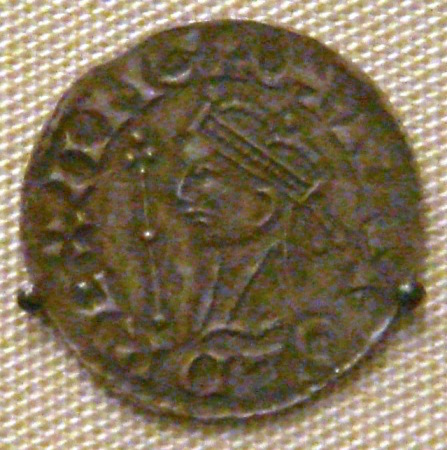
A coin bearing Harold II's portrait
Excerpt from Chronicle of the Saxon Kings, written 1290
Hīeraþ!(1)
This has been told.
In the Year of our Lord 1066, the king of England, Edward the Confessor, died. While he lay on his deathbed, his breath reaching its last counts, he named the great earl Harold Godwinson, lord of Wessex and of East Anglia and of Hereford, his successor. The mighty Harold, who was gloriously tall, strong, and handsome of face,(2) was taken to Westminster Abbey by the Lords of England, who were gathered in London for the feast of Epiphany, and there confirmed by the Witenagamot(3). The fair lord was crowned and set out to secure his rightful place as king of all England.
However, the greedy king of Norway, Harald Hard-Ruler(4), claimed the throne for himself and attacked in the north, where the brave earls of Northumbria steadfastly defended(5) against him. The perfidious Duke William the Bastard of Normandy also claimed the throne, and beguiled the innocent Pope into believing that it was his right(6). And so with papal support for his cause did the Bastard set forth from Normandy with thirty thousand men, intent on usurping Harold Godwinson's rightful throne. In early September did the great king Harold defeat the Norwegians at Stamford Bridge, slaying both the Hard-Ruler and his treasonous brother Tostig(7) with his own sword.
On the 28th of September did the fleet of the Bastard land at Sussex, burning and looting all they saw. The cruel Normans ravaged the land(8) until they reached Hastings, where the brave Harold waited with his army. A great battle was fought here, taking the greater part of a day. William was slain personally by the great king in a vicious hand-to-hand struggle(9). By October 1st, the other claimants to the throne of England were dead, Normandy was ensconced in a losing war with Brittany with most of her great lords dead at Hastings(10), and Harold II Godwinson’s rule was secure.
And so began the saga of Harold the Stalwart, greatest king of England.
Notes
1. 'Listen' in Old English. I would've had the whole thing in Old English and then a translation below, but I couldn't find a good enough translator.
2. This guy isn't biased at all, huh?
3. The Witenagemot is somewhat hard to explain. It was a political institution among the Anglo-Saxons which developed out of the old Germanic folkmoots or general assemblies, and included the ealdormen, the thegn, and the most senior clergy. It was essentially the House of Lords with a tribal, authoritarian, and far more feudal and religious flavor.
4. Harald Hardrada, in other words. Hardrada, interestingly enough, didn't have an actual family claim to England except through the King of Denmark, whose family had agreed with Hardrada's predecessor Magnus to grant him the throne of England, which the Danish Knytlings had taken several times.
5. Actually, they were getting their rears handed to them until Harold came up north.
6. Perfidious is the word. William was surprisingly sneaky for a guy named the Conqueror, and may have lied about papal support. For the sake of narrative, though, I'll assume the pope did in fact give him his support, and that he did in fact have Conan II of Brittany assassinated.
7. Tostig rebelled against Edward the Confessor in his last years. Harold strengthened his claim to the throne by fighting against Tostig and forcing him into exile. Tostig went to the court of Harold Hardrada and would later die at Stamford Bridge.
8. They never actually did, until after the conquest. Harrying of the North, anyone?
9. Actually, William's horse was killed from under him, and he died in the fall. Still, propaganda must be propaganda.
10. Conan II invaded Normandy in 1064, and was still fighting the Normans when he died during William's invasion of England.
1. 'Listen' in Old English. I would've had the whole thing in Old English and then a translation below, but I couldn't find a good enough translator.
2. This guy isn't biased at all, huh?
3. The Witenagemot is somewhat hard to explain. It was a political institution among the Anglo-Saxons which developed out of the old Germanic folkmoots or general assemblies, and included the ealdormen, the thegn, and the most senior clergy. It was essentially the House of Lords with a tribal, authoritarian, and far more feudal and religious flavor.
4. Harald Hardrada, in other words. Hardrada, interestingly enough, didn't have an actual family claim to England except through the King of Denmark, whose family had agreed with Hardrada's predecessor Magnus to grant him the throne of England, which the Danish Knytlings had taken several times.
5. Actually, they were getting their rears handed to them until Harold came up north.
6. Perfidious is the word. William was surprisingly sneaky for a guy named the Conqueror, and may have lied about papal support. For the sake of narrative, though, I'll assume the pope did in fact give him his support, and that he did in fact have Conan II of Brittany assassinated.
7. Tostig rebelled against Edward the Confessor in his last years. Harold strengthened his claim to the throne by fighting against Tostig and forcing him into exile. Tostig went to the court of Harold Hardrada and would later die at Stamford Bridge.
8. They never actually did, until after the conquest. Harrying of the North, anyone?
9. Actually, William's horse was killed from under him, and he died in the fall. Still, propaganda must be propaganda.
10. Conan II invaded Normandy in 1064, and was still fighting the Normans when he died during William's invasion of England.
